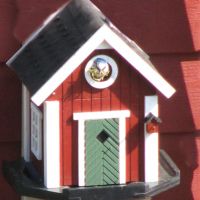
Wyvern
Wyvern
About
- Username
- Wyvern
- Joined
- Visits
- 3,140
- Last Active
- Roles
- Member
- Points
- 5,368
- Rank
- Cartographer
- Badges
- 24
-
1930's Overland Mountain Mapping
It really depends how close a match you want to that original Northern Italy map you linked to.
Looking closely at the book's image, it seems they used mainly one set of hatching lines to represent the general appearance of the landscape, with denser, longer hatching for what I imagine would be higher peaks and ridges, less dense, shorter hatching for lower hills. Occasionally, there is more than one such set of lines (Mt. Viso, a little below the 45° line on the map's left edge, has some complex examples, for instance), but this seems fairly rare, often used only for some of the higher, or possibly larger, more complexly-formed, mountains.
In places there does seem to be a "contour line" drawn for some - but by no means all - of the unhatched higher areas and hilltops, though that seems to be sometimes only on one side of the top, or only around part of it. In some cases, this seems to be an illusion due to the density of the landscape hatching lines. In others, it looks as if it has been drawn to show ridge or scarp features partway up a hillside too.
Similarly, the line density and direction can be variable in different places around the same peak or along the same ridge, probably to show ridges and spurs, or other smaller features, that can't be shown just using the "hatch and bare hilltop" style because of their sizes.
Unfortunately, because the map looks to have been drawn to try to replicate much of the overall patterns shown by the actual landforms, I'm not sure creating drawing tools will allow a very precise mimicking of the style, and might need to be done almost entirely by-hand, like the original. As I said though, this really depends how close a match you need your version of the style to be.
As Sue suggested, what you have now is a perfectly reasonable facsimile overall, though I would probably make less use of the dashed "contour lines". Maybe think of adding some of those blue speckled areas for the icy, glaciated highest peaks as well?
-
Wilderland Campaign
@Fersus - If you have the solo rules ("Strider Mode") for The One Ring, which are only available as a PDF still, as far as I know, those do add some more journey options which could be adapted for group play, or perhaps would help spark ideas. I've not played TOR yet, but it did strike me when just reading through all the rules (I have everything that Free League have published for it so far) that a lot of the random result tables generally were too short, so would be apt to become repetitive. I like Ralf's use of pre-prepared options along with the random rolls to make things more interesting overall, since as GM, you can't always come up with some worthwhile variant every time the same roll comes up otherwise.
-
New Commission. Ghorfar
-
The Expanse rpg; several starships, Annual scifi tiles and Cosmographer
My big problem with large ships is visualizing the layout/deck plans.
I forget whether you mentioned having a copy of any of the Metamorphosis Alpha RPG books or not now Jim, though I suspect from this comment probably not, as even the limited floorplans for the two complete decks, and the brief notes on all the others, in the first edition rules from 1976, would have given you a few pointers in this regard.
In one sense, Remy's right in suggesting it may help to think of the whole ship as like a huge city, actually more like a small country, given its gigantic size. Depending on how you envisage the entire craft as functioning, it's perfectly possible some of the decks might have a single function, or several major functions, each. Something like a farming deck for food production and air recycling, including breeding populations of domesticated animals, for instance, while there could be huge areas given over to parked-up machines on another deck for use on whatever planet the ship eventually reaches to colonise (since that's the primary reason such vast craft were envisaged originally). Elsewhere, there could be factories and machinery for use in them stored on another deck, again to get things functioning once the planet was reached, with maybe one entirely water-filled, for living aquatic foodstuffs, and as a water supply for the ship (could easily be segregated into fresh and sea water parts). Plus power supplies of varying kinds, of course.
It might help to work out what the total floor area is for the whole craft, and then compare that to a populated area on Earth somewhere, and see exactly what sort of features lie within a similar-sized zone, and what of those would be useful/essential on a ship destined to be in space for hundreds of years or more.
Hopefully in all this, we can help get you back on course!
-
Which style for... Post apocaliptic meshup
Yeah, I've been involved peripherally in a number of discussions elsewhere online lately regarding the use of AI art, including specifically that generated by Midjourney, because a lot of people - primarily artists - have become increasingly concerned about the direction this stuff is taking, most especially how the so-called AI systems are using artworks available online to generate their final images.
The matter is incredibly complex, and much of it remains uncertain, notably how copyright laws in various places pertain to AI-generated artworks, largely because they have never been legally tested this way (a couple of practicing US lawyers posted some very helpful discussions regarding the US situation a little while ago on one of the Discords I'm on, which were very enlightening in this regard).
I can do no better to help inform anyone here as to the current situation, than suggest those interested should read this blog posting from Dec 8th this year, by Jon Hodgson, a British "real" artist, RPG and game designer, who runs a company called Handiwork Games (which is where the blog is). Jon used Midjourney to generate much of the artwork in a new RPG he published this year, so he knows exactly what he's talking about from the genuine artist's perspective. He's also decided that any reprint of said RPG will have all the Midjourney artwork removed, to be replaced with his own, or other artists', real art, and he will not be using Midjourney, or other AI-generated artworks, again.
Personally, I've become very cautious about using any AI-generated artwork now, and would not do so in anything that wasn't purely for my own use.







